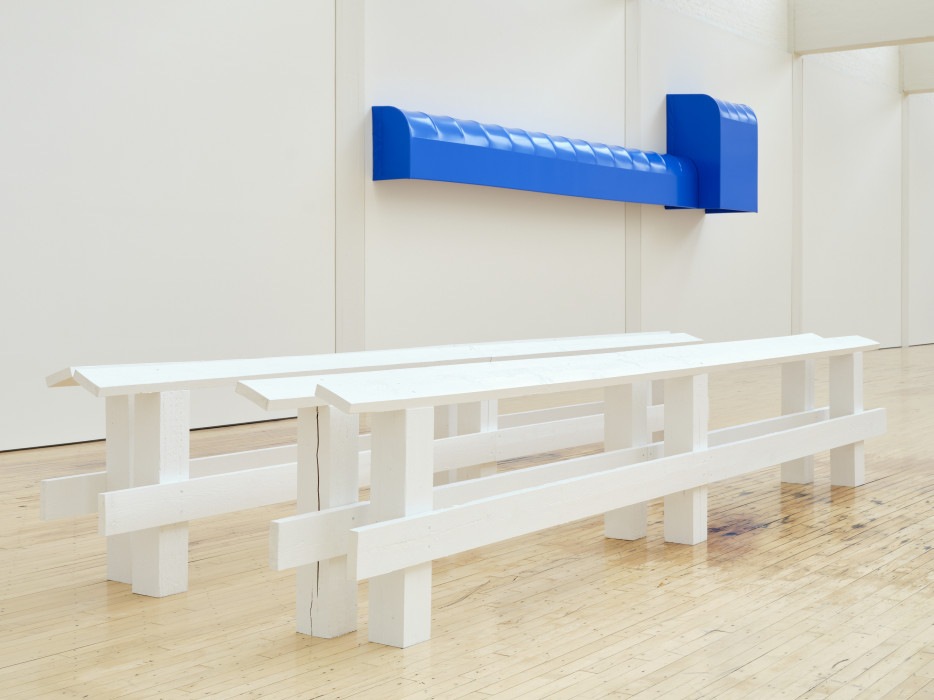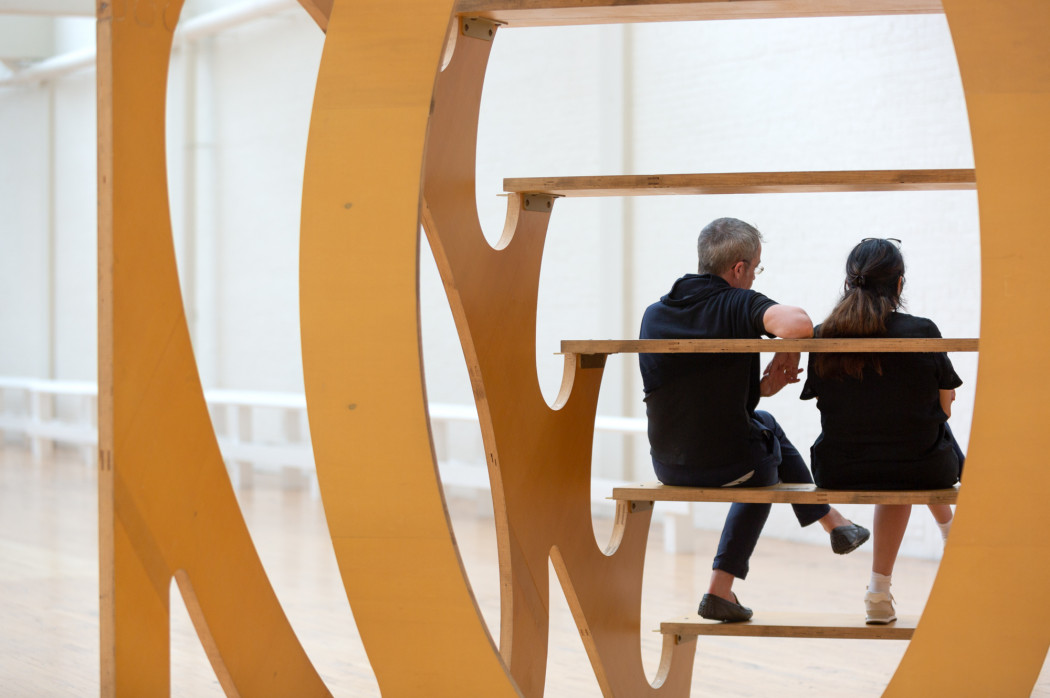Rita McBride: Arena Momentum
July 1, 2023–January 2025, Dia Beacon
Overview
Since the mid-1980s, Rita McBride has developed a conceptual, cross-disciplinary, intermedia, and feminist approach to art-making that holds collaboration at its center. This exhibition centers on the artist’s long-standing interest in architecture, design, and sculpture as they relate to the public sphere in forms such as seating structures, movement-guiding systems, and commercial awnings. At the core of Rita McBride: Arena Momentum, on view at Dia Beacon, is Arena (1997), a lightweight, modular structure in the form of a tribune that is activated by the presence of audiences and performers alike. Alongside Arena are freestanding and wall-mounted artworks from the last two decades that reflect McBride’s long-standing interest in how public infrastructures shape ways of looking.
Arena becomes an arena when animated by people in an ongoing and open process that is punctuated by choreographed engagements. For the duration of the presentation at Dia Beacon, an expanding body of artists, performers, writers, musicians, and dancers will activate physical and virtual spaces as part of a series of engagements with Arena. The series, collectively called Momentum, is initiated by McBride with experimental performance collective discoteca flaming star (founded by Cristina Gomez Barrio and Wolfgang Mayer) and artist and choreographer Alexandra Waierstall.
Momentum is live at Dia Beacon on the following dates: May 10 & 12, June 8, August 10, October 25–27, 2024.

Rita McBride: Arena Momentum is organized by Alexis Lowry, former curator at Dia, with Emily Markert, curatorial assistant. Public programming for the exhibition is organized by Matilde Guidelli-Guidi, curator and co–department head at Dia, with Emily Markert, and produced with Kim Golding, programs associate.
All exhibitions at Dia are made possible by the Economou Exhibition Fund.
Rita McBride: Arena Momentum is made possible by major support from Brenda R. Potter and Hope Warschaw. Significant support provided by Erika Glazer, and additional support by a Board Discretionary Grant of the Robert Rauschenberg Foundation, Graham Steele and Ulysses de Santi, and Konrad Fischer Galerie.
Since the mid-1980s, Rita McBride has, in her own words, “developed a conceptual, cross-disciplinary, intermedia, and feminist approach to art making that holds collaboration at its center.” She frequently works with architects, engineers, physicists, and other artists to produce works that simultaneously explore the relationships involved in their production and invite a variety of forms of participatory exchange. The exhibition Rita McBride: Arena Momentum highlights the artist’s long-standing interest in architecture, design, and sculpture as they relate to the public sphere in forms such as commercial awnings, movement-guiding systems like barricades and fences, and seating structures.
This exhibition includes freestanding and wall-mounted artworks from the last two decades that reflect McBride’s ongoing fascination with how public infrastructures shape ways of looking. Guide Rails (2020) comprises a modular system of white, wooden guiding-post and beam structures commonly found lining rural private roads and often associated with the famous Mulholland Drive in Los Angeles. However, the Guide Rails transcend particular locations, resembling an almost universal form used to mark divisions between public and private spaces. The freestanding elements extend through the gallery, informing the movement of visitors, in both speed and direction, and creating controlled sightlines and vantages. Guidance “Barriers” (2017) similarly suggests the ubiquitous manipulations of urban public space.¹ Guardrails (Highway) (2023) is mounted on the wall at eye-level and painted in shades of blue and purple to give the illusion of an unlimited horizon line. For McBride, these works resent machine-age concepts of absolute speed and risk, bringing to mind automobile test tracks, where guardrails predetermine an itinerary that is repeated lap after lap. Meanwhile, Awning (Blue Stand, City Block Blue) (2002) proposes a reading of the often-overlooked forms that inform our public spaces, rendering the familiar storefront awning as a moment of pause.
The site-specifically reconfigured Neighbors (2002/2023) is from a body of work that brings the form of the air duct, typically tucked away by architecture, from the background to the foreground, calling attention to these vital systems of cause and effect. Dislocated from their typically hidden status and painted in OSHA orange, the ventilation-like units come together to illustrate McBride’s interest in a characteristic concern of modernism—namely, the tension between form and functionality as it applies to our built environment. At the same time, many of these forms were originally designed following modern technological and industrial developments, such as the rise of the automobile necessitating ventilation systems to combat resulting air pollution. As McBride has written in connection with Charlotte Posenenske’s modular Series D (1967), which was recently on view in these galleries and also borrows shapes from ventilation units, “Ventilation ducts are like lungs, the essential life-giving mechanism of the body.”
At the core of the exhibition is Arena (1997), a lightweight, modular structure in the form of a tribune that is activated by the presence of audiences and performers alike. McBride explains that Arena is “an ongoing investigation into the ways public institutional space, art, and audiences interact.” The artwork becomes fully itself when animated by people in an ongoing and open process that is punctuated by choreographed engagements. For the duration of the presentation at Dia Beacon, multiple members of Momentum—an expanding body of artists, performers, writers, musicians, and dancers initiated by McBride with experimental performance collective discoteca flaming star (founded by Cristina Gómez Barrio and Wolfgang Mayer) and choreographer Alexandra Waierstall—will activate physical and virtual spaces as part of a series of interactions with Arena. Look for Momentum at Dia Beacon, October 13–15, 2023, and other dates in 2024.
Dia acquired Arena in 2021. As part of that process, the artist transitioned the digital files and conceptual parameters for the artwork into a copyleft license that is stewarded by Dia. This new status of Arena is emblematic of McBride’s commitment to the democratic principles of exchange, as well as her continued dedication to pushing the boundaries of institutional engagement. The copyleft files are freely available to the public in perpetuity, alongside Momentum Manifesto (2023), a large-scale poster designed by David Reinfurt. In the spirit of artists such as Bruce Nauman and Felix Gonzalez-Torres, visitors may take one of the posters, which are placed within the exhibition (and available in the bookshop). The invitation to interact with Arena by taking materials from the gallery space is in dialogue with the conceptual impulse of these artists and highlights the expectations and limitations placed on bodies in public—especially institutional art—spaces.
—Alexis Lowry with Emily Markert
- Guidance Barriers was first shown at Dia as part of the artist’s exhibition Particulates (2017–18).
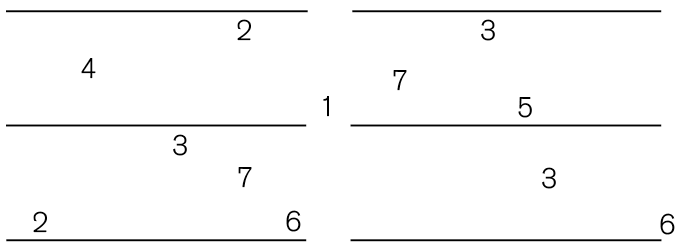
- Arena, 1997
Twaron and wood
Dia Art Foundation
*Arena involves heights. Children must be accompanied by an adult. Engage with this work at your own risk. - Guardrails (Highway), 2023
Acrylic lacquer, galvanized steel
Courtesy the artist - Guide Rails, 2020
Painted wood
Courtesy the artist - Guidance “Barriers,” 2017
Carbon fiber
Hammer Museum, Los Angeles, gift of Brenda R. Potter - Awning (Blue Stand, City Block Blue), 2002
Vinyl and aluminum
Courtesy Alexander and Bonin - Neighbors, 2002/2023
Painted galvanized steel
Courtesy Alexander and Bonin - Momentum Manifesto, 2023
Designed by David Reinfurt
*Posters are freely available in the gallery or in the bookshop on your way out. Please follow the poster’s instructions for folding before carrying it with you through the galleries.
Momentum performances:
October 13–15, 2023
Rita McBride was born in Des Moines in 1960 and lives in Düsseldorf and Los Alamos, California. She received a BA from Bard College, Annandale-on-Hudson, New York, and an MFA from the California Institute of the Arts, Valencia. In 1988, she began exploring architectural and sculptural form in works ranging from small-scale objects to public commissions. Her major public commissions include Mae West, Munich (2011); Bells and Whistles, the New School, New York (2014); and Obelisk of Tutankhamun, Cologne (2017). Major presentations include Rita McBride: Public Tilt, Museum of Contemporary Art San Diego (2014–15); Rita McBride: Gesellschaft, Kestner Gesellschaft, Hannover, Germany, and Kunsthalle Düsseldorf (2015–16); Rita McBride: Explorer, Wiels Centre d’Art Contemporain, Brussels (2017–18); Particulates, Dia Chelsea, New York (2017–18); National Chain 2020/Social Practices (in collaboration with Alexandra Waierstall and Fontys Dance Academy), Museum De Pont, Tilburg, the Netherlands (2021); and Rita McBride: Particulates, Hammer Museum, Los Angeles (2023). In 2001, she initiated a series of genre-bending publications that often use anonymous, collective writing structures. In 2018, she also initiated Particulates, an anthology of science fiction, edited by Nalo Hopkinson, that accompanied her exhibition Particulates at Dia Chelsea. McBride’s first project with Dia was a performative lecture on the work of Rosemarie Trockel as part of the 2003 Artists on Artists series.
Watch live feeds from the exhibition on the last Sunday of every month from 3:00pm to 5:00pm ET.

Related Events
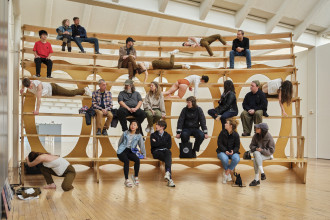
Performance
Momentum
Friday, May 10, and Sunday, May 12, 2024, Dia Beacon
Artist
Rita McBride
Rita McBride was born in Des Moines in 1960. She currently lives and works in Los Angeles and Düsseldorf.
Selected Works on View
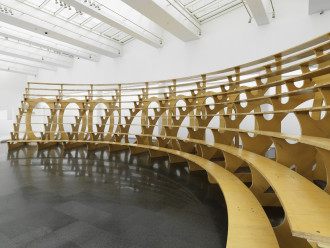
Rita McBride
Arena, 1997
Go to Arena page

